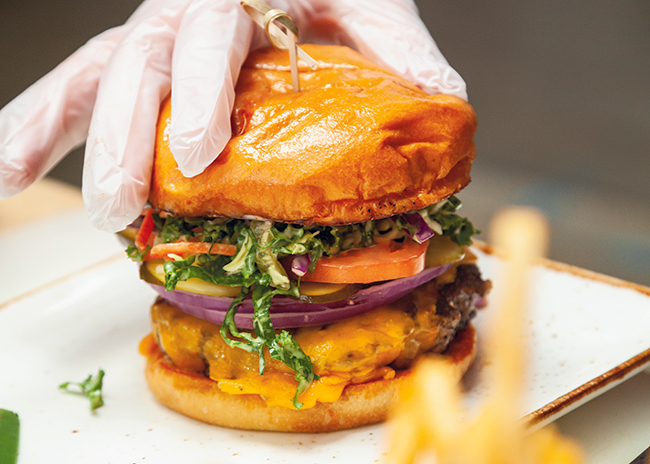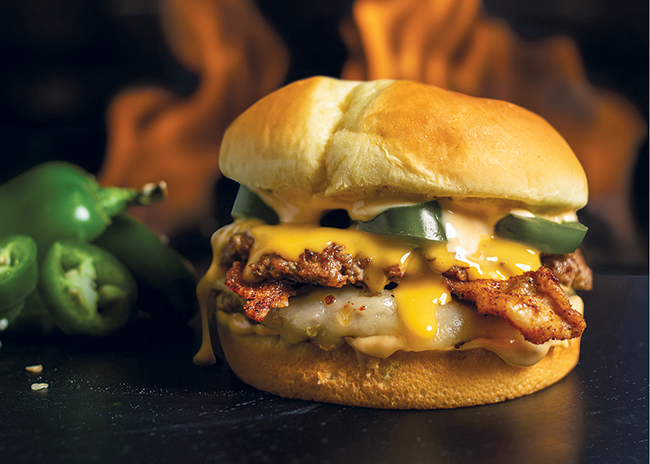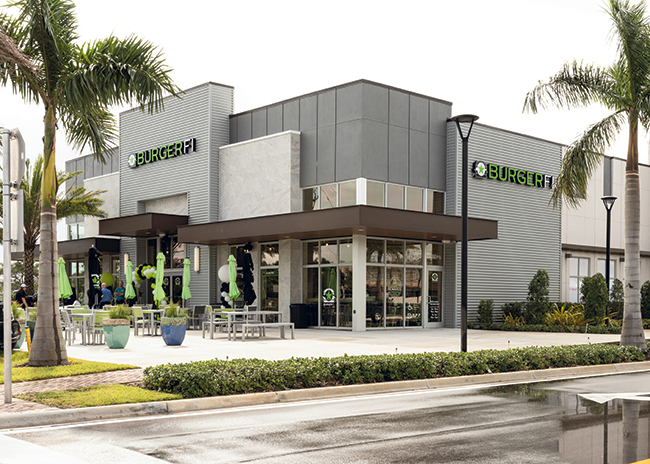There’s probably nothing more American than a good old-fashioned hamburger (although, admittedly, hot dog makers might disagree). They appear on 51% of menus, according to Mike Kostyo, trendologist for research firm Datassential. That makes them the sixth most common entree option on menus. And few other menu items match their popularity: 85% of customers say they like or love burgers, according to Datassential research.
 Photo by Bob HodsonEven in such a popular segment, though, the old tried-and-true doesn’t cut it anymore. “Premiumization continues to drive trends in burgers,” says Kostyo, “with options like aioli, brioche buns, caramelized onion, aged cheddar and tomato jam all growing on burgers.” Nontraditional toppings such as hummus, tzatziki and even peanut butter are showing up on burgers as well. And the desire for creative innovation goes beyond toppings, he adds, noting that “chefs and operators continue to look for ways they can swap out a traditional or classic option” when it comes to the burger patty itself. Options beyond ground beef, such as wagyu, brisket and short rib, are all gaining in popularity, he says.
Photo by Bob HodsonEven in such a popular segment, though, the old tried-and-true doesn’t cut it anymore. “Premiumization continues to drive trends in burgers,” says Kostyo, “with options like aioli, brioche buns, caramelized onion, aged cheddar and tomato jam all growing on burgers.” Nontraditional toppings such as hummus, tzatziki and even peanut butter are showing up on burgers as well. And the desire for creative innovation goes beyond toppings, he adds, noting that “chefs and operators continue to look for ways they can swap out a traditional or classic option” when it comes to the burger patty itself. Options beyond ground beef, such as wagyu, brisket and short rib, are all gaining in popularity, he says.
Trendspotting
Customization is the wave of the future for burgers, says Daniel Bendas, managing partner of Synergy Restaurant Consultants in Newport Beach, Calif. “The burger is becoming a little bit like pizza, where the dough is the canvas and you can put almost whatever you want on it,” he says. “So the burger becomes a vehicle for adding more interesting toppings or multiple meats.”
Entrepreneur and restaurant consultant Mark Brezinski is opening a new concept called Bizzy Burger in North Dallas later this year. He plans to take the opposite tack at Bizzy: going smaller, with fewer toppings. “If you look at New York, the trend is very much small burgers,” he says. His basic burger will be 1.75 ounces, with double- and triple-patty options available. He plans to procure his beef from a local butcher and limit the toppings available to guests. “We’re going to have a sign — a leaf of lettuce with a line through it. No lettuce. BYOL — bring your own lettuce if you want it. No cold toppings are going to go on our burger.”
The smashed burger prep style continues to grow in popularity too. Datassential notes a 200% increase for smashed burgers on menus over the past four years. Brezinski’s Bizzy Burger will smash its burgers to get, as he says, a “heavy caramelization, a good crust on it and a really juicy, seasoned grill.”
Bendas says producing a good smashed burger requires “a little bit more labor and skill. You can’t just send it through a conveyor grill or broilers, but it can be really good when it’s done right.”
 Wayback Burgers introduced its Fiery Bacon Burger in the winter of 2021. The chain continues to work on adding limited-time menu items in an uncomplicated operational format.The trend of big, bold flavors continues to be popular with customers at the Cheshire, Conn.-based Wayback Burgers chain, says president Patrick Conlin. “We just came off a limited-time offer called the Fiery Bacon Burger, which is a two-patty burger with jalapeños and bacon [which has been] dusted with Texas Pete hot seasoning. Last fall, we had a limited time offer called the Big Easy, a Cajun burger with a spicy, creamy remoulade sauce.” The Big Easy was so popular with customers that it has now been added to Wayback Burgers’ permanent menu lineup.
Wayback Burgers introduced its Fiery Bacon Burger in the winter of 2021. The chain continues to work on adding limited-time menu items in an uncomplicated operational format.The trend of big, bold flavors continues to be popular with customers at the Cheshire, Conn.-based Wayback Burgers chain, says president Patrick Conlin. “We just came off a limited-time offer called the Fiery Bacon Burger, which is a two-patty burger with jalapeños and bacon [which has been] dusted with Texas Pete hot seasoning. Last fall, we had a limited time offer called the Big Easy, a Cajun burger with a spicy, creamy remoulade sauce.” The Big Easy was so popular with customers that it has now been added to Wayback Burgers’ permanent menu lineup.
Current Headwinds, Future Challenges
According to Patrick Renna, president of the 116-unit BurgerFi chain based in North Palm Beach, Fla., the biggest change he has seen in the burger segment lately is the influx of new players. “Many more players have gotten into the burger segment,” he notes. “You have players in casual dining or fine dining now doing a subset of their concept. So it’s creating more and more competition, which makes it more important to be on top of your game.”
Conlin says there has been a “big evolution” in the burger segment. Consumers seek a “higher-quality burger and better-quality meat than the typical fast-food burger. Fast food is always going to be there, but I think generally the consumer is looking for the higher-quality product with better flavor.”
Bendas says that the biggest change he’s seen in the burger segment has been operators laser-focusing on the things they do best, which he says has led to the growth of chains such as In-N-Out Burger and Shake Shack. “Burger places that are very focused on a core product do very limited things extraordinarily well,” he says. “They can just focus on delivering a great burger consistently.”
The challenges for the burger segment today keep “coming from all angles,” notes Renna. “In the past, it’s usually one headwind versus a tailwind. Commodities could be in a good place and labor’s not in a good place or vice versa. Today, the biggest challenge has been commodities, and this inflationary period we thought was going to be temporary — it’s our belief that it’s here for a while. Couple that with labor challenges and it’s safe to say the business model has changed from pre-pandemic to where we are today.”
One of those major headwinds the burger segment (and every other segment) faces today is supply chain issues. Bendas calls it a serious problem. “The supply chain for meat is obviously a big problem, and I’m personally concerned with what’s going on in Europe and what’s happening with wheat.”
Conlin says it’s the biggest problem his chain faces today. “The issues with food products, for us, have generally died down somewhat. The issues now are with paper products and packaging.”
For many restaurants, switching to a business model based on takeout and delivery was critical in surviving the pandemic. Because many burger places were already positioned for takeout with drive-thru lanes, they easily made the switch to a totally off-site style of service. But the jury is still out on whether this is a permanent change in the way they do business or just a temporary phase. Wayback Burgers has indoor seating areas and “early on, there was talk about, ‘Should we shrink our footprint because people aren’t dining?’ ” says Conlin. “But we decided this is going to end at some point. So we don’t want to go from a footprint between 1,600 and 1,800 square feet to a 1,200-square-foot footprint thinking it’s going to be a majority delivery business.”
As business started to recover, Conlin says, “we would’ve been in some trouble if we’d really constricted the size of our restaurants.” He does, however, foresee some changes in the traditional seating patterns. “I don’t think you’re going to see a fast-casual restaurant like us or a quick-service restaurant have the seating as close together as it was in the past. I don’t think the normal consumer is going to want to be sitting on top of a stranger.”
 BurgerFi’s president Patrick Renna notes that segment challenges, notably inflation and labor, will remain for a while.Renna at BurgerFi anticipates continued popularity for takeout, which presents some packaging problems. The typical burger-and-fries order, he says, “loses something as it sits longer. When you take that transaction to a customer who is 10, 15, 20 minutes [away], you’re losing the integrity of the product. Packaging becomes more important. So that’s a challenge for the burger segment.”
BurgerFi’s president Patrick Renna notes that segment challenges, notably inflation and labor, will remain for a while.Renna at BurgerFi anticipates continued popularity for takeout, which presents some packaging problems. The typical burger-and-fries order, he says, “loses something as it sits longer. When you take that transaction to a customer who is 10, 15, 20 minutes [away], you’re losing the integrity of the product. Packaging becomes more important. So that’s a challenge for the burger segment.”
The concept of price elasticity — or, basically, how much of a cost increase customers will be willing to bear before they stop buying — affects every facet of foodservice but has a unique effect on the burger segment. Since burgers have historically been viewed as an inexpensive food, consumers can be particularly sensitive to price hikes on their favorite burger. And with rising inflation and the frequent increases in the cost of food products, it’s a bigger issue than ever. “When I say ‘burger’ to you, your mind is going to say what you’re willing to pay,” says Brezinski. While the effect might be negligible in higher-end or destination establishments, he thinks it may soon be a limiting factor in fast-casual establishments. “As you start to get more ‘regular’ burgers at $12, $13 and $14, I think people are going to say, ‘What am I buying
here right now?’ There’s not as much elasticity as there is with a steak.”
Bendas agrees, noting that “people are forgiving in understanding price hikes. However, I think there’s a level at which it’s going to become intolerable, and they just simply can’t afford to go out. Personally, I think we’re getting close to that point.”
When it comes to delivery, besides the problem of keeping the food hot and fresh-tasting, price elasticity comes into play as well. “QSR doesn’t have that much room to play with,” says Brezinski. “In most neighborhoods, you can’t charge an extra 20% to somebody for delivery of a quarter-pound burger with cheese.”
All of these trends and challenges have an effect on back-of-the-house operations. Paul Griffin, culinary director for BurgerFi, explains how delivery, for example, can have a snowball effect on kitchen operations. During a crunch period, “back in the day, you would send a waiting couple or party to the bar to give the kitchen a little bit of time. But now you can have five delivery services, and those orders come in as if you have five open registers. So the speed of incoming orders affects how the employees interact.”
Difficulties in the supply chain also can create labor issues, says Conlin. “In the past, we’ve done burgers where we’ve brought in three, maybe four items for an LTO [limited-time offer] burger,” he says. “Today we probably would not do something like that, to bring in four items. It makes the operation that much more difficult.” Along those same lines, he says, an LTO that required a unique piece of equipment would mean “you have to look at the cost of training the staff on how to use that equipment.” To get around those issues, he says, the chain works on building new flavors or sauces that bring big flavor to their burgers but are operationally uncomplicated.
A Meatless Future?
Undoubtedly, the biggest news in burgers in the past few years has been the explosion in plant-based and non-meat burgers. Datassential’s Kostyo notes that the Beyond Burger, Impossible Burger and the overall term “plant-based burger” hold down the top three spots when it comes to fastest-growing burger options on menus over the past four years.
But adding a plant-based burger to menus hasn’t been a quick decision for every chain. Conlin notes that although Wayback Burgers has had a traditional veggie burger on its menu, he was at first hesitant to add a plant-based burger. Prodding from his office staff eventually got him to request samples and add it to the menu as a test, even though some franchisees were at first reluctant. One of his franchisees quipped that it would be “impossible” to sell. “We launched it [as an LTO] in February 2020. Sales were very good, but the pandemic hit in March. Dine-in shut down, and sales went in the tank for a couple of months,” he says. After the LTO, he says he was amazed by the response. “The customer feedback that we got on our website, in our social media channels — I’ve never seen that about an LTO product. We had so much feedback from people saying, ‘When are you bringing that back? Are you going to make it a permanent menu item?’ ” Conlin says he’s happy to admit his mistake, as the plant-based burger is now a permanent fixture on the menu at Wayback Burgers and it continues to bring in new customers.
Plant-based burgers are here to stay, says Bendas, who also sees an increase in complementary products as well. “I think more products will become available. There’s been a lot of progress made in non-dairy cheese products,” he says. “It’s just going to continue to grow over time. The technology and the quality of the products will also get better — not that it’s not pretty good now.”
Renna says that the boom in plant-based burgers may lead to a new subgenre of burger restaurants. “Plant-based product will lead to more menu item innovation, and then potentially more concepts that could just be plant-based concepts,” he says. “We’ve seen a couple of them in the past, but I think it’ll just continue to grow. When you ask, ‘How can the burger segment grow more than it is?’ It’s doing it through innovation and cleaner food.”



